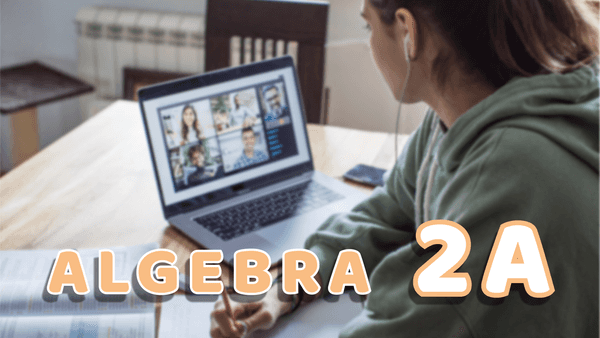Algebra 2A
Whether they’re loving math and want more, or want extra support, Juni’s ready to teach Algebra 2. This high school algebra course covers quadratic functions, polynomials, rational functions, and radical and piecewise functions. It prepares students for Pre-Calculus and Trig.

- Private 1:1
- Format
- Age 14-17
- Learners
- Weekly
- Classes
- 50 minutes
- Per class

About this Course
Billing
Billed as
$275 / month
Scheduling
1:1 classes are 50 minutes long and can be scheduled anytime Monday-Sunday from 7am to 7pm PT. To begin, select Book your Placement Class to signup. Our team will then match you and set up your first class!
- Course duration4-6 months
- Lesson50 minutes
Learning Targets
Complex Numbers
Complex-1: The student can define real, imaginary, and complex numbers
Complex-2: The student can simplify radical expressions using i
Complex-3: The student can compute powers of i
Complex-4: The student can identify complex numbers graphed on the complex plane
Complex-5: The student can graph complex numbers on the complex plane
Complex-6: The student can add and subtract complex numbers
Complex-7: The student can multiply and divide complex numbers
Quadratic Functions
Quadratic-1: The student can solve a quadratic using factoring
Quadratic-2: The student can factor quadratic equations where the leading coefficient is 1
Quadratic-3: The student can factor quadratic equations where the leading coefficient is not 1
Quadratic-4: The student can multiply two binomials using FOIL
Quadratic-5: The student can factor a square binomial
Quadratic-6: The student can factor a difference of squares
Quadratic-7: The student can solve a quadratic by completing the square
Quadratic-8:The student can solve a quadratic using the quadratic formula
Quadratic-9: The student can use the discriminant to determine the number and types of roots a quadratic has
Quadratic-10: The student can find non-real roots using the quadratic formula
Graphing Quadratic Functions
GQ-1: The student can plug values into a quadratic equation to find points on its parabola
GQ-2: The student can graph a parabola by points
GQ-3: The student can identify the direction and wideness of a parabola by its leading coefficient
GQ-4: The student can identify the coordinates of the vertex of a quadratic in vertex form
GQ-5: The student can identify the coordinates of the x-intercepts of a quadratic in intercept form
GQ-6: The student can find the standard form equation of a quadratic given 3 points
GQ-7: The student can convert a quadratic between vertex form and standard form
GQ-8: The student can convert a quadratic between intercept form and standard form
GQ-9: The student can convert a quadratic between vertex form and intercept form
GQ-10: The student can perform vertical and horizontal translations on a quadratic
GQ-11: The student can reflect an equation across the x-axis
GQ-12: The student can reflect an equation across the y-axis
GQ-13: The student can scale a quadratic by a factor
GQ-14: The student can apply multiple transformations to a quadratic
Higher-Degree Polynomials
Polynomials-1: The student can identify the degree of a polynomial
Polynomials-2: The student can add and subtract higher-degree polynomials
Polynomials-3: The student can find the product of two higher-degree polynomials
Polynomials-4: The student can factor a higher-degree polynomial by grouping
Polynomials-5: The student can factor out the GCF of a higher-degree polynomial
Polynomials-6: The student can identify and use special factorizations for higher-degree polynomials
Polynomials-7: The student can divide two polynomials using polynomial long division
Polynomials-8: The student can divide two polynomials using synthetic division
Zeros of Polynomials
Zeros-1: The student can use the Rational Zeros Theorem to generate a list of possible real rational roots
Zeros-2: The student can use the Fundamental Theorem of Algebra to determine the total number of roots for a function
Zeros-3: The student can use the Complex Conjugate Root Theorem to determine all of the possible options for real and complex roots
Zeros-4: The student can use Descartes’ Rule of Signs to determine the maximum number of real positive or real negative roots
Zeros-5: The student can find the bounds on zeros
Zeros-6: The student can use synthetic division to test possible zeros generated by the Rational Zeros Theorem
Graphing Polynomials
GP-1: The student can identify the end behavior of a function using the degree and leading coefficient
GP-2: The student can categorize a function as even, odd, or neither
GP-3: The student can identify the domain and range of a function
GP-4: The student can identify local maximum and local minimum points of a graph
GP-5: The student can sketch a graph given the sign of the leading coefficient, the degree, and some key points
GP-6: The student can reflect an equation across the x-axis and the y-axis
GP-7: The student can perform vertical and horizontal translations on a function
GP-8: The student can vertically and horizontally scale a function by a factor
GP-9: The student can apply multiple transformations to a function
Rational Functions
Rational-1: The student knows what an asymptote is
Rational-2: The student can find a vertical asymptote
Rational-3: The student can find a horizontal asymptote
Rational-4: The student knows what a removable discontinuity is
Rational-5: The student can find removable discontinuities
Rational-6: The student can analyze the domain and range of a rational function from its graph
Rational-7: The student can analyze the end behavior of a rational function from its graph
Rational-8: The student can graph a rational function
Rational-9: The student can find the roots of a rational function
Rational Function Operations
Operations-1: The student can multiply rational expressions
Operations-2: The student can divide rational expressions
Operations-3: The student can add rational expressions
Operations-4: The student can subtract rational expressions
Operations-5: The student can solve a rational equation
Radical Functions
Radical-1: The student can graph a radical function
Radical-2: The student can analyze the domain and range of a radical function
Radical-3: The student can analyze the end behavior of a radical function based on its graph
Radical-4: The student can analyze the transformations done to the parent function
Radical-5: The student can solve radical equations
Piecewise Functions
Piecewise-1: The student can evaluate a piecewise function at different values of x
Piecewise-2: The student can graph a piecewise function
Piecewise-3: The student can determine where a piecewise function is continuous and discontinuous
Piecewise-4: The student can derive the definition of a piecewise function based on its graph
Piecewise-5: The student can write and solve a piecewise function definition based on a real world situation
Piecewise-6: The student can graph a step function
General Mathematical Skills
I can explain what the question is asking for.
I can explain my thinking behind my work.
I check my work carefully during or after I finish a question.
When I am stuck on a question, I show perseverance by trying a new method or asking for help.
When I am stuck on a question, I use what I know to find a place to start.
General Learning Habits
Joyful Collaboration
- I practice listening to my instructor and sharing my ideas to co-create understanding.
- I attempt tasks independently and ask my instructor questions when I need help.
Unlimited Curiosity
- I take ownership of my learning by asking meaningful questions both when I need clarification and when I want to know more about a topic.
Nimble Determination
- I practice resilience when I am frustrated that I have not yet achieved mastery of a new concept or skill; instead of complaining about challenges, I try new approaches and creative solutions.
Invest in Excellence
- I arrive to class on time and prepared to learn, with my computer set up with a strong internet connection.
- I complete my homework on time, and if I cannot complete my homework due to other obligations, I honestly communicate the reasons for late homework to my instructor.
- I do my best to stay present and on task for the whole session. I support my focus by putting away any distracting technology and setting notifications on my device to “do not disturb” mode.
Homework
Instructors will assign students roughly 60 minutes of class related problems at the end of each session. Homework is generally pulled from Juni's curriculum and is meant to complement the class experience and ensure the student continues to learn and grow outside of the session
Pre-Requisites
Completion of both Algebra 1 and Geometry
Who are Juni’s Instructors?
Our instructors are subject matter experts from top US universities. Instructors are highly-vetted and background checked prior to joining and undergo extensive training before ever teaching on our platform.
Upon signing up, parents are asked a series of questions that allow us to match your child with an optimal instructor based on their unique needs and interests. Factors that are considered in our matching process include Learning Style, Personality, Personal Experience, and Academic & Career Aspiration.

More Courses You Might Like
Real Reviews from Real Parents
Ray
My 3 sons ages, 10 1/2, 9 and 7 started using Juni in early June 2020 and absolutely love it. The instructors are college age kids and they relate to my boys very well. My oldest is doing both the coding and math tracks and I feel like he will be way ahead of his 5th grade class come the fall. Once the other two are old enough I will certainly be enrolling them in math as well.
Tarun Mehta
Juni has been amazing for my daughter. She is a reluctant learner when it comes to Computer Languages, but the Juni instructors have been engaging to her at a level where she feels comfortable with them and they manner in which they present the curriculum. They understood my ask that I Wanted her to start liking computer languages, and they are presenting the information in a way that is fun and relatable. I am very happy with my Juni experience and my daughter's journey with Juni so far!
Pooja
I have two boys taking classes and the Juni takes the time to match the right instructor for my children. They are patient and very consistent in their teaching. The boys are thoroughly enjoying their class and love accomplishing and learning new things!





